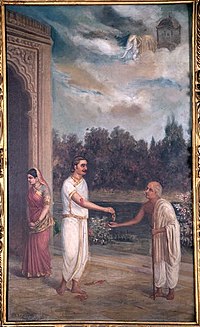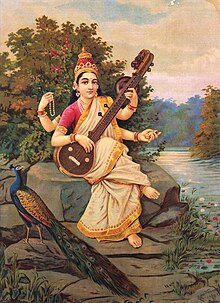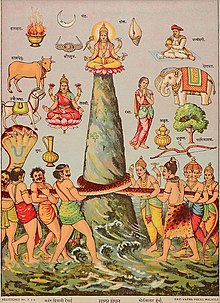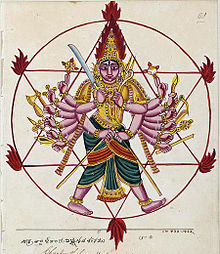| It has been suggested that this article be split into a new article titled List of weapons in Hindu mythology. (discuss) (December 2022) |
| This list needs additional citations for verification. Please help improve this article by adding citations to reliable sources in this list. Unsourced material may be challenged and removed. Find sources: "List of mythological objects" Hindu mythology – news · newspapers · books · scholar · JSTOR (March 2017) (Learn how and when to remove this message) |
| This list has no precise inclusion criteria as described in the Manual of Style for standalone lists. Please improve this article by adding inclusion criteria, or discuss this issue on the talk page. (March 2017) |
The following is a list of various mythological objects described in Hindu literature.

Armour
- Karna Kavacha - The armour of Karna that was granted to him by his father Surya at birth, offering him virtual invulnerability.
- Brahma Kavacha - The armour of Brahma which will make its wielder couldn't harm by any weapon. In Ramayana Ravana and Atikaya, in Mahabharata, * Arjuna and Duryodhana used this.
- Shiva Kavacha - The armour of Shiva which will make its wielder invincible.
- Indra Kavacha : Granted by Indra to Arjuna, making him invulnerable.
- Varaha Kavacha : Granted by Varaha (Vishnu's boar avatar) to Bhima, offering protection.
Vessels

- Kalasha - the kalasha is considered a symbol of abundance and "source of life" in the Vedas. It is referred to as "overflowing full vase" in the Vedas. The kalasha is believed to contain amrita, the elixir of life, and thus is viewed as a symbol of abundance, wisdom, and immortality. The kalasha is often seen in Hindu iconography as an attribute, in the hands of Hindu deities like the creator god Brahma, the destroyer god Shiva as a teacher, and the goddess of prosperity Lakshmi.
- Kamandalu, kamandal, or kamandalam - an oblong water pot made of a dry gourd (pumpkin) or coconut shell, metal, wood of the Kamandalataru tree, or from clay, usually with a handle and sometimes with a spout. The kamandalu is used in Hindu iconography, in depiction of deities related with asceticism or water. It is, thus, viewed as a symbol of ascetism in Hinduism. Adi Shankaracharya’s ashtotaram hymn praises Shiva whose hand is adorned with the kamandalu. Other deities like the fire-god Agni and the preceptor of the gods, Brihaspati, are depicted carrying the kamandalu.
- Kapala - (Sanskrit for "skull") or skullcup is a cup made from a human skull used as a ritual implement (bowl) in both Hindu and Buddhist Tantra.
- Kumbha - a type of pottery in India. It symbolises the womb, thus it represents fertility, life, generative power of human beings and sustenance and is generally associated with devis, particularly Ganga.
- Akshaya Patra - Akshayapatra (means an inexhaustible vessel), is an object from Hindu theology. It was a wonderful vessel given to Yudishtira by the Lord Surya which provided a never-failing supply of food to the Pandavas every day.
- Akshaya Tunira - the inexhaustible quiver of arrows of Arjuna, offered to him by Agni.
Flags
Further information: Dhvaja- Garudadhvaja - The flag of Vishnu.
- Indradhvaja - The flag of Indra.
- Kakkadhvaja - The flag of Jyestha.
- Kapidhvaja or Vanaradhvaja - The flag of Arjuna.
- Makaradhvaja - The flag of Kamadeva.
- Kukkutadhvaja - The flag of Kartikeya.
- Vrishadhvaja - The flag of Shiva.
Flora
Plants
- Ausadhirdipyamanas - These are healing plants capable of phosphorescence. They are used for healing and rejuvenations in battle. These are used by the Ashvins.
- Eraká grass - The grass that grew from the cast away powdered iron-bolt belonging to Samba. It was used to destroy the Yadu race, as it miraculously turned into an iron-bolt in the hands of its wielders.
- Kusha grass - The Kusha grass is specifically recommended by Krishna in the Bhagavad Gita as part of the ideal seat for meditation.
- Padma - The lotus plays a central role in Indian religions such as Hinduism, Buddhism, Sikhism, and Jainism. Hindus revere it with the gods Vishnu, Brahma, and to a lesser degree Kubera, as well as the goddesses Lakshmi and Saraswati. They are regarded as an exemplar of divine beauty and purity.
- Saugandhika flower - This was a lotus flower that was sought after by Bhima (for Draupadi) during the Pandavas exile. It was found in Kubera's pond.

Hanuman retrieves Sanjeevani by taking the entire mountain - Sanjeevani - Sanjeevani is a magical herb which has the power to cure any malady. It is believed that medicines prepared from this herb could revive a dead person.
- Tulasi - The holy basil is a sacred plant in Hindu belief. Hindus regard it as an earthly manifestation of the goddess Tulasi; As the incarnation of Lakshmi, she is regarded as a great worshipper of the god Vishnu.
Trees
- The Tree of Jiva and Atman - This tree appears in the Vedic scriptures as a metaphysical metaphor concerning the soul.
- Amalika - The veneration of the amla tree in particular is due to the belief that the god Vishnu resides in and near the tree, particularly on Amalaka Ekadashi.
- Ashoka tree - The ashoka tree is closely associated with the yakshis, the nature spirits.
- Atti - In the Atharvaveda, the fig tree is given prominence as a means for acquiring prosperity and vanquishing foes.
- Bilva tree - This is a sacred tree and used to worship Shiva.
- Kadamba - The kadamba is mentioned in the Bhagavata Purana. In North India, it is associated with Krishna while in the south it is known as "Parvati’s tree". The kadamba tree is also associated with a tree deity called Kadambariyamman.

- Parijata - The divine flowering tree with blossoms that never fade or wilt - taken to Indraloka by the devas.
- Sala tree - In Hindu tradition, the sala tree is said to be favoured by Vishnu. It is also associated with salabhanjika or shalabhanjika (also known as madanakai, madanika, or shilabalika).
- Akshayavata (Indestructible Banyan Tree) - It is a sacred fig tree. The sage Markandeya asked Narayana to show him a specimen of the divine power. Narayana flooded the entire world for a moment, during which only the Akshayavata could be seen above the water level.
- Kalpavriksha (also Kalpataru, Kalpadruma or Kalpapādapa) - It is a wish-fulfilling divine tree in Hindu mythology.
- Ashvattha (also Assattha) - A sacred tree for the Hindus and has been extensively mentioned in texts pertaining to Hinduism, mentioned as 'peepul' (Ficus religiosa) in Rig Veda mantra I.164.20. Buddhist texts term the tree as Bodhi tree, a tree under which Gautama Buddha meditated and gained enlightenment.
Jewellery
Garland|Mala
|
Instruments

Drums
- Damaru or damru (a small two-headed drum) - The damru is known as the instrument of the deity Shiva, and is said to have been created by Shiva in order to produce the spiritual sounds by which the whole universe was created and regulated.
- Mridangam or tannumai in Tamil (wooden double-headed drum) - Nandi is said to have played the mridangam during Shiva's primordial tandava dance, causing a divine rhythm to resound across the heavens. The mridangam is thus also known as "Deva Vaadyam" or "Divine Instrument".
Wind instruments
- Nandni Vardhanam - The Conch of Satyaki.
- Panchajanya - a Shankha conch shell of the Hindu god Vishnu.
- Shankha - A conch shell which is of ritual and religious importance in both Hinduism and Buddhism. The Shankha is a sacred emblem of the Hindu preserver god Vishnu. It is still used as a trumpet in Hindu ritual, and in the past was used as a war trumpet.
- Yogesha Nadam - The conch of Shiva.
- Venu - The venu (a bamboo transverse flute) is associated with Krishna, who is often depicted playing it. Also one of the form of Devi Matangi as Venu Shyamala.
String instruments
- Mahathi - The veena of Narada (a Vedic sage).
- Saraswati veena - The veena of Saraswati, Hindu goddess of knowledge, music, arts, wisdom and learning.
- Rudra veena - As Rudra is a name for the Hindu god Shiva, rudra vina literally means "the veena dear to Shiva".
Substances

- Amrita - The nectar produced from the Samudra Manthana, which upon consuming, granted the gods immortality.
- Halahala (also called 'kalakuta') - The Samudra Manthana process released a number of things from the Ocean of Milk. One was the lethal poison known as Halahala. This terrified the gods and demons because the poison was so powerful that it could destroy all of creation. Shiva consumed the poison in an act to protect the universe.
- Soma (Sanskrit) or Haoma (Avestan) - It is described as being prepared by extracting juice from the stalks of a certain plant. In both Vedic and Zoroastrian tradition, the name of the drink and the plant are the same, and also personified as a divinity, the three forming a religious or mythological unity.
Treasures
- Navaratna - The sacred nine gems or treasures.
- Nidhi - The nine treasures (navanidhi) belonging to Kubera, the god of wealth.
- Ratnas - The fourteen treasures produced during the Samudra Manthana.
Vehicles
Chariots

- Yayati's chariot - A divine chariot which could travel in any direction unimpeded, employed by King Yayati.
- Rahu's chariot - The deity rides a chariot drawn by eight black horses.
- Surya's chariot - The chariot of Surya, charioteered by Aruna and drawn by seven horses.
Vahana
- Vahana - It denotes the being, typically an animal or mythical entity, a particular Hindu deity is said to use as a vehicle. In this capacity, the vahana is often called the deity's "mount".
Vimana
- Hansa Vimana - a flying machine/ personal plane of Lord Brahma, it is driven by swans and is completely white in colour.
- Pushpaka Vimana or Dandu Monara - Pushpaka was originally made by Vishvakarma for Brahma, the Hindu god of creation; later Brahma gave it to Kubera, the god of wealth; but it was later stolen, along with Lanka, by his half-brother, king Ravana.
Weapons

- Anrita - The name of one of the mystical weapons delivered to Ráma by Viswámitra, as mentioned in the Rámáyana.
- Ayudhapurusha - The anthropomorphic depiction of a divine weapon in Hindu art. Ayudhapurushas are sometimes considered as partial incarnates of their divine owners.
- Indra's net - The net was one of the weapons of the sky-god Indra, used to snare and entangle enemies. The net also signifies magic or illusion.
Shastra
- Ankusha - An elephant goad that is one of the eight auspicious objects known as Astamangala. Ankusha is also an attribute of many Hindu gods, including Ganesha.
- Balachita - A plough used as a weapon by Balarama, brother of Krishna.
- Chentu - A horse whip which looks like a crooked stick, and is a typical attribute of Ayyanar, Krishna in his aspect as Rajagopala, and Shiva with Nandi
Gada
- Sunandha - Gada of Bhalaram.


AstraMain article: Astra (weapon) See also: Indrajit and Karna

|
Miscellaneous

- Ashtamangala - The Aṣṭamaṅgala are a sacred suite of Eight Auspicious Symbols.
- Chhatra - An umbrella, according to Hinduism, is the emblem of Varuna. A number of deities are depicted with chatra, and they include Revanta, Surya, and Vamana (the 5th avatar of Vishnu).
- The Dharmachakra (IAST: dharmacakra; Pali dhammacakka; "Wheel of the Dharma"), is one of the Ashtamangala.
- Devi-Gola of the Hindus, balls which are supposed to fall from the gods or the heavens. Most likely meteors.
- Hiranyagarbha (World egg) - The source of the creation of the universe or the manifested.
- Prana - All the cosmic energy, permeating the Universe on all levels. Prana is often referred to as the "life force" or "life energy". It also includes energies present in inanimate objects.
- Rama Setu In the Ramayana, the vanaras named Nala and Nila construct a floating bridge (known as Rama Setu) across the sea, using stones that floated on water because they had Rama's name written on them.
- Rudraksha, also rudraksh, ("Rudra's/Shiva's Teardrops"), is a seed traditionally used for prayer beads in Hinduism.
- Stambha (also spelled as Skambha) - In the context of Hinduism, is believed to be a cosmic column. It is believed that the stambha functions as a bond, which joins the heaven (Svarga) and the earth (prithvi).
- Vedic amulet - In Vedic literature, fig trees often represent talismans with the udumbara fig tree having been deemed the "lord of amulets".
- Wheel of time (also known as Kalachakra) is a concept found in several religious traditions and philosophies, notably religions of Indian origin such as Hinduism, Sikhism, and Buddhism, which regard time as cyclical and consisting of repeating ages.
See also
References
- http://sanskritdocuments.org/all_sa/shankara108m_sa.html, Shankarachrya’s ashtotaram)
- Jansen, Eva Rudy (1993). The Book of Hindu Imagery. Binkey Kok Publications. p. 158. ISBN 9789074597074. Retrieved 2008-08-21. p.52
- Chaplin, Dorothea (2007). Mythlogical Bonds Between East and West. READ BOOKS. p. 160. ISBN 9781406739862. Retrieved 2008-08-21. p.117
- Chakrabarti, Dilip K. (2001). Archaeological Geography of the Ganga Plain. Orient Longman. p. 301. ISBN 9788178240169. Retrieved 2008-08-21. p. 40
- Darian, Steven G. (2001), The Ganges in myth and history, Motilal Banarsidass, p. 125, ISBN 978-8120817579,
The Kumbha: After the Makara, Ganga's most distinctive sculptural feature is the full vase, first appearing with the river goddess on the same Varaha cave frieze from Udaygiri. Although not common in the early stages of the Ganga image, the full vase appears more and more frequently as the Ganga theme reaches maturity.
- Gopal, Madan (1990). K.S. Gautam (ed.). India through the ages. Publication Division, Ministry of Information and Broadcasting, Government of India. p. 65.
- The Mahabharata. Pitambar Publishing. 1997. p. 27. ISBN 978-81-209-0732-4.
- Books, Kausiki (2021-10-24). Narada Purana Part 1: English Translation only without Slokas. Kausiki Books. p. 423.
- Sri Ramakrishna Math (1985) "Hanuman Chalisa" p. 9
- Bane, Theresa (2020-05-29). Encyclopedia of Mythological Objects. McFarland. p. 24. ISBN 978-1-4766-3920-8.
- Website dedicated to the story of Karna
- "4. Amba and Bhishma". Mahabharataonline.com. Retrieved 30 April 2013.
- Devdutt Pattanaik (8 January 2002). The man who was a woman and other queer tales of Hindu lore. Harrington Park Press. p. 60. ISBN 978-1-56023-180-6. Retrieved 18 May 2013.
- Gopal, Madan (1990). K.S. Gautam (ed.). India through the ages. Publication Division, Ministry of Information and Broadcasting, Government of India. p. 62.
- Kinsley p. 63
- Kinsley pp. 67–8
- Kinsley p. 171
- Kinsley p. 98
- Kinsley p. 153
- Kinsley p. 167
- Kinsley p. 180
- Kinsley p. 246
- D Dennis Hudson (27 August 2008). The Body of God Emperor's Palace for Krishna in Eighth-Century Kanchipuram: An Emperor's Palace for Krishna in Eighth-Century Kanchipuram. Oxford University Press. pp. 168–. ISBN 978-0-19-970902-1.
- Prof. Shrikant Prasoon (17 February 2014). Hinduism Clarified and Simplified. V&S Publishers. pp. 235–. ISBN 978-93-81384-72-5.
- Rūpagosvāmī (2003). The Bhaktirasāmṛtasindhu of Rūpa Gosvāmin. Motilal Banarsidass. pp. 575–. ISBN 978-81-208-1861-3.
- Venkatesananda, Swami (1984). The Concise Yoga Vāsiṣṭha. Albany: State University of New York Press. pp. 346–353. ISBN 0-87395-955-8. OCLC 11044869.
- "Syamantaka spelling". Archived from the original on 2011-09-28. Retrieved 2009-02-09.
- "Syamantaka Story". Retrieved 2009-02-09.
- Brown (October 2007). Ancient Astrological Gemstones & Talismansfirst=Richard Shaw. Hrisikesh Ltd. ISBN 978-974-8102-29-0.